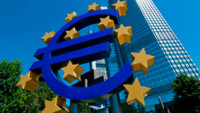 Global equity markets picked up where US markets left off at the end of last week yesterday, continuing the recovery that has been in place since the lows at the beginning of the month.
Global equity markets picked up where US markets left off at the end of last week yesterday, continuing the recovery that has been in place since the lows at the beginning of the month.
Having come off the back of such a sharp sell-off it’s taken some time for investors to start putting money back into the market but it does appear that while US yields continue to soften, as they have done in particular on the US 10 year, which hit a one week low, investors seem content to drip feed money back into the equity market, though this trend has accelerated for US markets in the last three days, with both major indices within 4% of their previous record highs.European markets also continued their recent rebound, and look set to open higher again today but in contrast to the gains seen stateside the rebound has been a little less exuberant.
Today’s focus is likely to be on Washington DC later today as new Fed chair Jerome Powell sits in front of US lawmakers in his first semi-annual congressional testimony. If markets want to make a judgement on whether we can expect to see four rate rises this year then the tone of Powell’s remarks could go some way to supporting that premise. With other Fed policymakers making increasingly optimistic noises about the US economy, Randal Quarles, the vice chairman of financial supervision on the Fed board being the latest in comments last night, Powell is going to find it increasingly difficult to dial back expectations, especially given the recent tax changes which are likely to filter through in the coming months.
I suspect that while he won’t want to box himself into a corner, he is unlikely to want to paint a different picture to the rather hawkish interpretation of the minutes of last months Fed meeting which suggested that US policymakers are increasingly optimistic about the glide path of the US economy.
In Europe we’re likely to continue to see a focus on inflationary pressure or the lack of it, in light of ECB President Mario Draghi’s remarks yesterday to the European Parliament, with the latest flash CPI numbers from Spain and Germany later today, followed by a February flash EU CPI due tomorrow.
Today’s Spanish flash CPI for February is expected to rise to 0.9% from 0.7%, while German flash CPI is expected to drop to 1.3% from 1.4%, highlighting the difficulties faced by the ECB in setting monetary policy for a region that has completely different fiscal policies.
On the currencies front the euro pulled off its lows after Angela Merkel’s CDU party voted massively in favour of a coalition deal with the SPD. This was never really in doubt, the key test remains this weekend when the SPD membership votes on the deal, where support for the deal is much more divisive, while the Italian election on the same day, 4th March also has the potential to introduce fresh uncertainty into European politics.
The pound had a choppy day briefly hitting a one week high against the dollar and euro after Deputy Governor of the Bank of England Dave Ramsden said that interest rates could rise sooner rather than later. His remarks are significant given he voted against the recent decision to hike rates. The pound soon slipped back as the US dollar rebounded.
Today’s US data is likely to have been affected by the recent cold weather in the same way yesterday’s new home sales data for January probably was, as we saw a decline of 7.8%, following on from a 7.6% decline in December.
January durable goods are expected to decline 2.4%, while consumer confidence for February is expected to tick up to 126.4 in February.
EURUSD – currently stuck in a range between the peaks this year at 1.2530 and solid support just above the 1.2200 area with a bigger area of support at 1.2160. A break of this sideways consolidation is likely to give a decent indicator of the next move, with a slight bias towards the downside after the key day reversal of a few days ago.
GBPUSD – moved up to 1.4070 yesterday before slipping back as the recent range continues to compress. Long term support still remains down near the 1.3750 area while a break below that and the 50 day MA could prompt a move back to the 1.3660 area, which prompted the recent move higher.
EURGBP – still range trading but with a bias lower for now. While below the 0.8910 area which has held for all of this year the bias remains for a return to the lower end of the recent range at 0.8740.
USDJPY – the rebound off last week’s lows at 105.54 needs to push above the 107.30 level to stabilise and open up a move back to 108.00.












